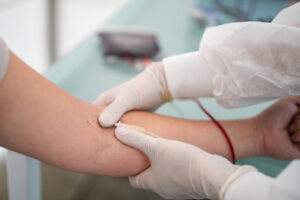Previous studies have identified risk factors for vasovagal reactions (VVRs) in blood donors, including young age, female sex, lower body weight, lower estimated blood volume, and being a first-time donor. Researchers have developed a scoring system to help determine the relative importance of each of the risk factors and predict donors most at risk for pre-syncopal and syncopal symptoms in Japan. Using data from over 577,000 whole blood donations in 2019 and 2020 (0.50% experienced VVRs), the permutation variable importance for each risk factor for VVRs was determined and then tested. The most important variable was donor status (first time donors and donors with a history of VVR) followed by age, estimated blood volume and height. Based on a scoring system which weights each variable, researchers were able to predict those donors with a greater likelihood of experiencing pre-syncopal and syncopal symptoms. Those with the lowest scores had VVR rates of 0.09% compared to those with the highest scores who had VVR rates of 3.11%. By predicting which donors have a higher likelihood of experiencing syncopal symptoms, blood centers may be able to mitigate the negative impact of VVRs on donor well-being and likelihood of return.
Reference:

